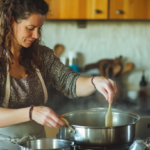Welcome to the ultimate recipe entrepreneur guide. Ever dreamed of making money from your kitchen creations? The online recipe market is booming. More food lovers are turning their passion into profit. Whether you’re a professional chef or a passionate home cook, now is the time to start selling recipes.
In this article, we’ll guide you through the steps to start selling recipes with ease. We’ll cover everything from finding your niche to picking the right platform for your business. Follow these steps, and you’ll soon join the ranks of successful online food entrepreneurs. Get ready to turn your favorite dishes into a profitable business.
Understanding market trends and knowing your audience is key, as detailed in this guide on making money by selling recipes. We aim to help you succeed in the digital world. Let’s ensure your culinary business thrives in today’s digital age.
Key Takeaways
- Identify and define your recipe niche.
- Ensure high-quality, clear recipe presentations.
- Choose the right platform to sell your recipes.
- Build a strong online presence and engage with your audience.
- Optimize your recipes for SEO to enhance visibility.
- Create appealing and search-friendly recipe titles and descriptions.
- Utilize analytics to track performance and improve sales.
Why Sell Recipes Online?
Starting an online recipe business opens many doors for budding culinary entrepreneurs. The internet has more people looking for meal ideas than ever before. This makes selling recipes an attractive and doable idea.
Market Demand for Online Recipes
The need for online recipes is big, thanks to more folks wanting new meal ideas and culinary tips. 43% of internet users globally search for recipes and cooking advice online. This creates a perfect chance to make money from a food blog by selling recipes. People are always searching for new, tasty recipes for all meal times and dietary needs.
Potential Audiences for Recipe Sales
The people interested in buying recipes online are varied, giving you many ways to make money. You can reach:
- Food Enthusiasts: Home cooks and food lovers eager to try new recipes in their kitchens.
- Dietary-Specific Groups: Those needing recipes for special diets like vegan, keto, gluten-free, or low-carb.
- Professional Chefs and Restaurants: Chefs and eating places looking for new, creative recipes for their menus.
- Busy Professionals and Parents: Folks who need quick, simple recipes that fit their busy lives.
Targeting these diverse groups can boost your income and add value to people’s cooking experiences worldwide. Selling recipes on a food blog is a flexible, rewarding way to share your love of cooking and make money, too.
Creating a Unique Selling Proposition for Your Recipes
In today’s digital market, having a strong Unique Selling Proposition (USP) is key for food entrepreneurs. It makes your recipes stand out to potential customers. By showing what’s special about your dishes, you can market them better.
Defining Your Recipe Niche
Pick a niche that matches your cooking skills and passion. It could be healthy meals, quick recipes, or gourmet ethnic foods. A specific focus helps attract the right customers and boost sales.
For example, KFC grew from one location to a huge chain by focusing on its niche and USP. Zara appeals to young, budget-aware shoppers with low-cost fashion.
The 4P analysis (Product, Place, Price, Promotion) helps evaluate your niche. This ensures you stand out from competitors.
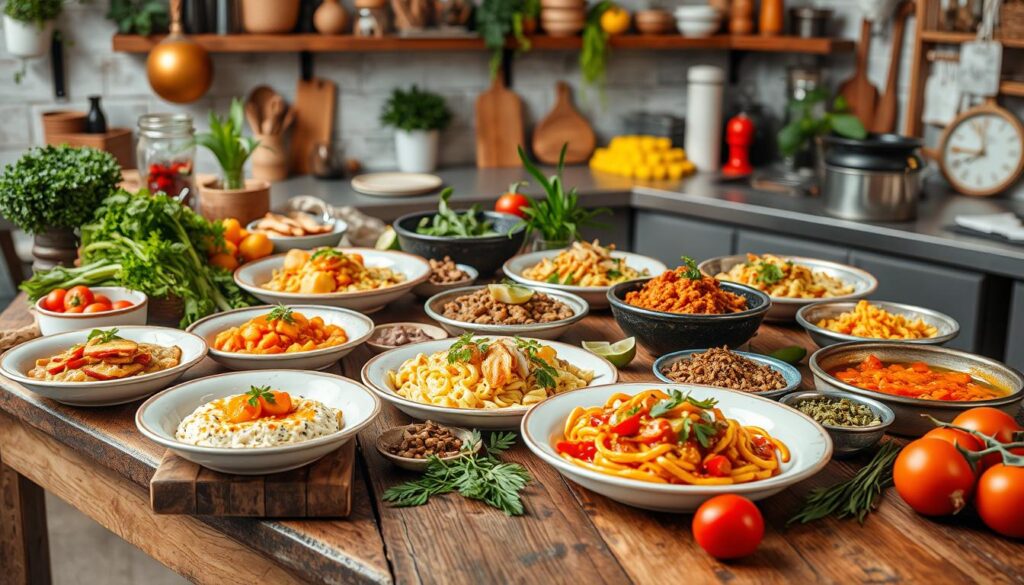
Identifying Your Unique Recipe Features
It’s important to showcase what makes your recipes special. Key features might include:
- Affordable Ingredients – Recipes that don’t break the bank.
- Quick Preparation Times – Easy meals for busy people.
- Health Benefits – Good-for-you food options.
Zara’s focus on keeping prices low and Sony’s dedication to straightforward game development show the value of unique features. Highlight what makes your recipes different.
Understanding competitors is critical to a solid USP. Knowing their strengths and weaknesses helps you stand out to your audience. This can lead to more interest and sales.
For ideas on making your recipes profitable, check out creative ways to earn from your cooking here.
Preparing Your Recipes for Sale
Turning your cooking skills into a product means more than making a meal. It’s about sharing your knowledge in a clear way. A great recipe guide makes it easier for people to make your dishes. Let’s dive into key steps for getting your recipes ready to sell.
Recipe Writing Tips for Clarity
When writing recipes, it’s important to be clear. Start with a short intro about what’s special about your recipe. Use simple words to avoid confusing those new to cooking. Stick to precise measurements, as advised by 65% of top recipe makers, for reliable outcomes.
Importance of Quality and Standardized Measurements
Being consistent with measurements helps everyone get the same tasty result. List ingredients in their usage order—most chefs say this helps readers. Mention the size of pots and spoons needed; it aids beginners. Share nutritional facts to attract those watching their diet, who are nearly half your buyers.
Including Descriptive Steps and Doneness Tips
Clear steps do more than instruct; they boost confidence in the kitchen. Simplify hard tasks and use hints for checking if a dish is ready. Tips for understanding when food is properly cooked are great for newbies. Including these in your guide builds trust and can lead to more sales of your digital recipes.
Following these tips makes your recipes easy to use and ready to shine in the food market. Use these methods for memorable recipes that keep your readers coming back.
Choosing the Right Platform to Sell Your Recipes
Selling recipes online can be a great way to make money, especially with the right platform. It’s important to choose between a marketplace or your own website. This decision greatly affects your success. Here, we explore the benefits and drawbacks of both to help you make a smart choice. This way, you can earn from your cooking skills better.
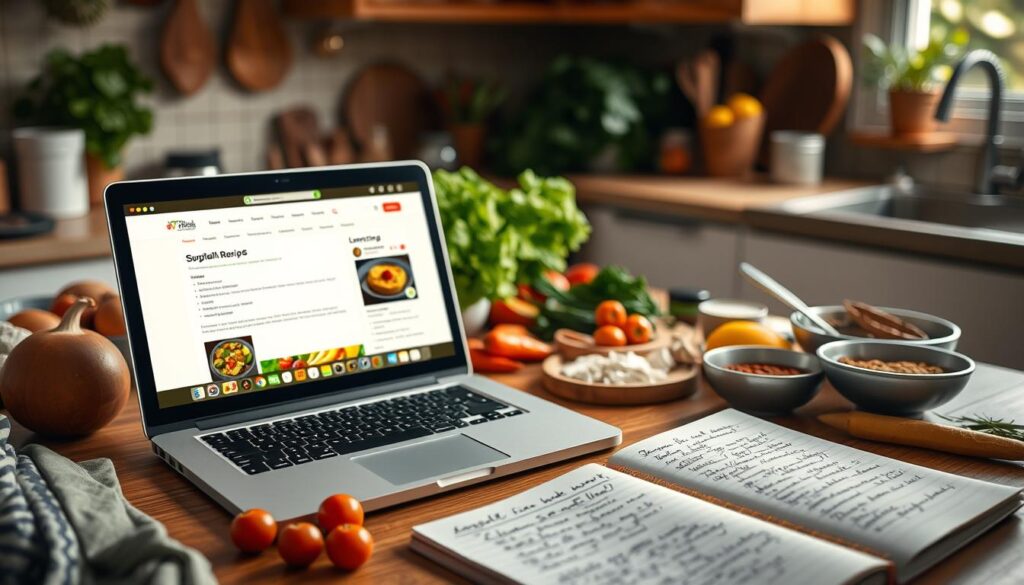
Pros and Cons of Marketplaces
Marketplaces like Etsy come with a built-in audience. This is great for beginners. In fact, 43% of internet users worldwide look online for what to cook (Statista). So, marketplaces can quickly get your recipes noticed. But, marketplaces are crowded, with over 1,000 sellers competing on Etsy alone. They also take a cut of your earnings.
Moreover, selling on big platforms might make your brand seem less unique. These sites control how you interact with customers. It’s key to know these points to see if a marketplace fits your business goals.
Benefits of Having Your Own Online Store
Having your own online store has many advantages. You control your brand and how you connect with customers. Tools like Sellfy can help manage your sales without hidden costs. This gives you freedom in how you sell.
Your own store means you can market your way and avoid head-to-head competition. With 58% of Instagram users loving food content, direct marketing can really work. Success stories like Ashley Renee show what’s possible with creative marketing.
Yes, starting your own store is more work at first. You need to build the website and keep marketing. Yet, the chance to stand out and earn from your cooking makes it worth it. Choosing the right platform prepares you for a profitable recipe business.
Building Your Online Presence
Starting an online recipe business needs a strong online presence. It’s key to attracting devoted fans. Here are several points to remember as you build your web presence.
Creating Content Around Your Recipes
Great content grabs attention. Your culinary skills, along with helpful info for buyers, should shine. Adding quality photos and videos makes your content pop. These help draw in more readers, raising your chances to make sales. For instance, on HubPages, freelancers keep 60% of ad revenue from posts with top-notch pictures.

Using Social Media to Gain Followers
Social media is key for pushing out your recipes. Being regular and original helps grow your audience fast. Poppy O’Toole saw her TikTok followers hit 100,000 in just seven months. This brought her ad deals and a cookbook. Instagram, Facebook, and Pinterest are crucial for food bloggers, with most using them. Hashtags can make you 29% more noticeable.
Engaging with Your Audience
It’s vital to connect with your followers for a successful recipe business. Reply quickly and try live cook demos or polls for input. Blogs with fun, interactive parts get 30% more reader activity. Being open about ads wins trust. 83% of readers tend to trust bloggers who are upfront about sponsorships.
Starting your recipe-selling journey? Focus on engaging content, smart social media, and talking with your audience. Using these recipe selling tips will help you build a strong circle and grow your business.
7 Easy Steps to Start Selling Your Recipes Today
Ever thought about making money from your cooking skills? Selling recipes online is a great chance, especially for starters. Here, we’ll show you a simple way to begin this delicious adventure.
-
Identify Your Best Recipes: Start with picking your finest recipes. Choose dishes loved by many and tested for quality and taste.
-
Write High-Quality Recipes: Write your recipes so they’re easy to follow. Mention how long they take, servings, and what’s in them. Don’t forget to list any allergens for people with food sensitivities.
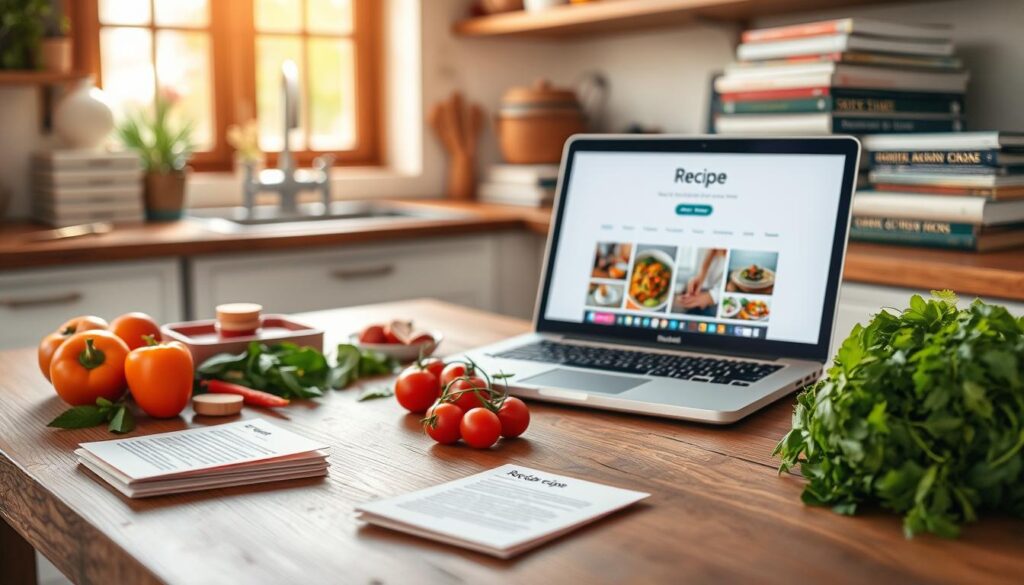
-
Choose the Right Platform: Think about where to sell. Online marketplaces or your own site? Both offer benefits like reaching lots of people or creating your brand.
-
Develop a Unique Selling Proposition (USP): Decide what makes your recipes stand out. Maybe it’s vegan options, whole foods, or fast recipes. This will help attract folks interested in what you offer.
-
Create an Online Presence: Set up a site or a blog for your dishes. Share tips and connect with people on social media. Great photos and videos of your cooking process can make you more noticeable.
-
Optimize for Search Engines: Use keywords to make your recipes easy to find online. Write great titles, descriptions, and use good pictures to boost your chances of being seen.
-
Market and Promote: Use social media ads and work with influencers to get the word out. Being consistent with your brand and sharing engaging content will gain customers’ trust and increase sales. A solid promotion plan is key for easy recipe monetization.
Follow these steps, and you’ll start to make money from your recipes. It turns your cooking passion into a profitable business. Whether you’re just starting or looking to get better, the trick is to begin small and grow wisely.
Optimizing Your Recipe Listings for SEO
Getting your recipes noticed online means mastering SEO. With most people not looking past the first search results page, optimizing is key. This guide will show you how to make your recipes stand out to viewers.
Keyword Research and Implementation
At the heart of selling recipes is finding the right keywords. Most searches use long-tail keywords. Use tools like Google Keyword Planner and SEMrush to see what folks are looking for. Adding these keywords to your content can boost your search rankings.
Creating Search-Friendly Recipe Titles and Descriptions
Knowing how to sell recipes online means nailing your titles and descriptions. They need to grab attention and include key search words. Words like “best ever,” “super tasty,” “easy,” or “quick” draw users in. Great titles and clear descriptions increase the chances people click on your recipes.
Importance of High-Quality Photos
Great photos are crucial for recipe success. They draw people in and keep them interested. Quality images make your recipes more appealing and improve user experience.
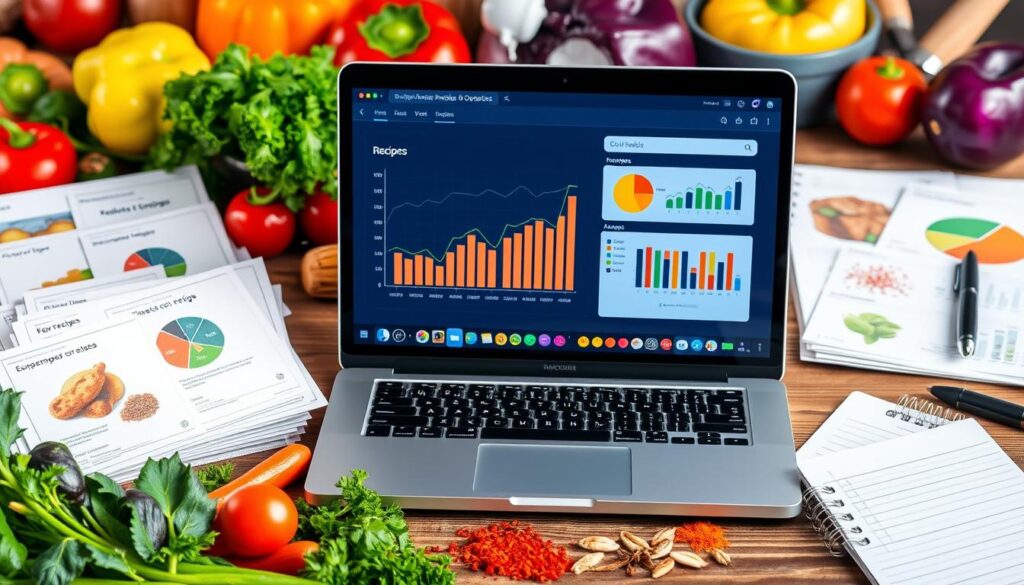
WP Tasty offers tools like Tasty Pins and Tasty Recipes for better image and content optimization. Adding keywords to your image descriptions also helps with SEO. These steps can help food bloggers get better rankings, more site visits, and a stronger online presence.
Pricing Your Recipes
Setting the right price for your recipes is key to earning the most profit. Start by knowing your target market and what they think your dishes are worth. It’s also vital to figure out how much each recipe costs to make. For instance, in NYC, a custom 8-inch layer cake commonly sells for about $100. This is because it uses better ingredients and can be customized.
When pricing recipes, calculate the cost of ingredients and how much labor goes into each dish. Labor costs should only include the time you’re actively working, not when waiting for something to cool or set. Consider making an in-depth spreadsheet for every ingredient’s price. This way, you cover both changing and constant costs, like cake boxes or how fast your equipment wears out. It’s also crucial to think about hidden costs since they can really add up.
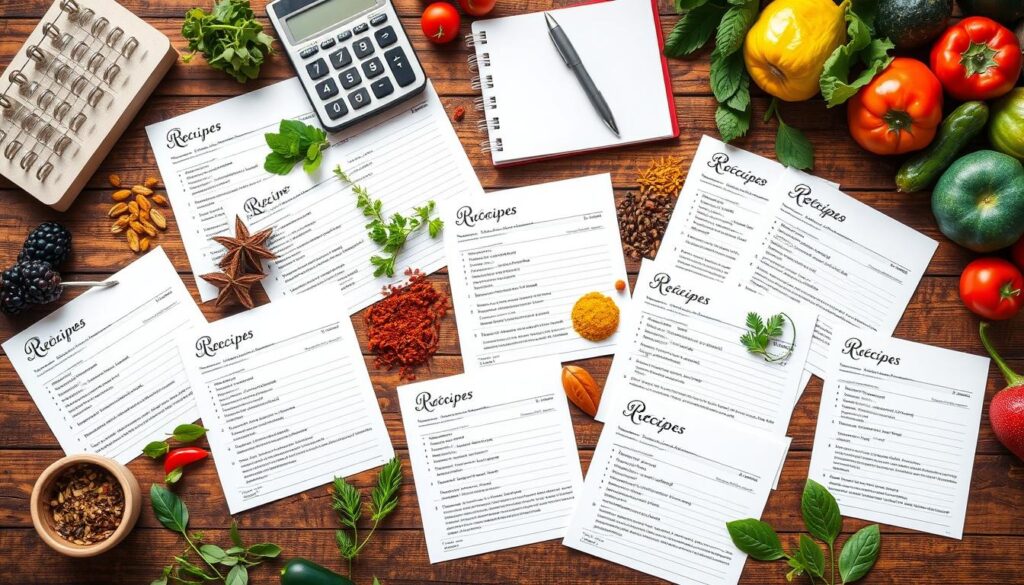
The success in selling recipes leans on more than the cost of ingredients. Talking to local bakers can give you insights into current prices. This community approach helps in setting your own prices right. Plus, with the cookbook market expected to reach $15 billion by 2028, selling recipes online is promising. E-cookbooks are now a big part, about 25%, of this market. This opens up great chances to make money.
Also, focus on making your recipes special to justify higher prices. Use top-notch ingredients and customized recipes to beat the competition. If customers aren’t complaining about prices, your rates might be too low. Keep in mind, knowing recipe pricing strategies and listening to customer feedback is key. This approach will support your income and success in selling recipes over time.
Marketing and Promoting Your Recipes
For any online recipe business to succeed, marketing recipes online is key. You can reach more people and get more interaction by using social media ads. Working with influencers also helps get your recipes out to a bigger, diverse crowd.
Leveraging Social Media Ads
Social media sites like Facebook, Instagram, and Pinterest are great for sharing recipes online. They have many users, which helps you find people interested in cooking and food. Pinterest, for example, brings in about 50 million visitors looking for meal ideas, making it a top spot for finding recipes.
Take Instagram ads, which can find users who love food and cooking. About 58% of Instagram users really care about this topic, and 36% are encouraged to try new foods. Using ads on these sites can bring a lot of traffic to your recipes.

Collaborating with Influencers
Working with influencers can greatly promote your recipes. Take Ashley Renee, who has over 522K followers on Instagram and more than 611.6K on TikTok. Her first viral TikTok video brought in 15K new followers, showing how influencers can help grow your recipe business.
Teaming up with influencers puts your recipes in front of their fans. This means more people might see and try your recipes. Make sure the influencers you work with share your brand’s values and are a good fit for your recipe niche. This approach increases engagement and can lead to more sales.
Managing Customer Interactions and Feedback
Handling customer interactions and feedback well is key to your online recipe business’s success. Talking with your customers in a positive way can improve their experience a lot. It can also increase customer loyalty and satisfaction.
Responding to Customer Queries
In the customer service in recipe sales world, quick and thoughtful replies are crucial. Studies have found that food businesses that talk to customers increase loyalty by 63%. This shows how important it is to answer quickly.

You might consider an automated system to reply to questions right away. Then, give a full answer as soon as you can. Being this attentive can really change how customers see your business.
Incorporating Customer Feedback for Improvement
Using recipe business customer feedback can majorly improve what you offer. About 77% of shoppers like when businesses make giving feedback easy. Listening to this feedback helps you see where to improve recipe products.
Surveys can give you important insights and help keep 20% more customers. Always ask for their thoughts on new recipes and ways to make current ones better. This not only shows you care about quality but also values their input.
“90% of consumers read online reviews before visiting a business, making it imperative to manage customer feedback effectively.”
Using feedback to better your recipes and service can make customers more satisfied and loyal. They like when businesses listen and change based on what they say.
In summary, making customer service in recipe sales and recipe business customer feedback top priorities can really improve your online business and keep customers coming back.
Utilizing Analytics to Improve Sales
In today’s online recipe market, using analytics can really boost your strategy. By focusing on recipe sales analysis and utilizing insights from data, you can make your online business better.
Tracking Performance and Sales Conversion
It’s key to know how your sales are doing. Using tools to track recipe sales lets you see important metrics. These include how many transactions you have and their average size. Shopify gives detailed analytics. This helps you understand your customers and improve your recipes to meet their needs.
Adjusting Strategies Based on Data
Adjust your marketing strategies by analyzing recipe sales. This lets you see which recipes sell better at certain times or during promotions. This insight helps you tailor your strategy to fit what your customers like.
It’s vital to continually optimize your online business because of the vast data available. Always look over your performance metrics to keep your strategy on point.
Choosing the right tools is important for better tracking of recipe sales. Shopify has different plans to fit your needs, offering deep dives into analytics for smarter sales strategies. With customizable themes, courses, and 24/7 support, these tools make optimizing your business smoother, setting you on a clear path to success.
Scaling Your Recipe Business
If you want to grow your recipe business, it’s key to scale up. This means growing your recipe list and earning money in different ways. By doing so, you’ll get more customers and make more money. Let’s look at the steps to achieve this.
Expanding Your Recipe Offerings
First off, grow your recipe collection. Add new types of meals to attract various customers. For example, add brunch or vegan dishes alongside desserts.
Make sure each new recipe is well-tested. Follow a thorough process, like in “Celebrate Every Day,” where recipes are checked by both pros and home cooks. Also, using exact measurements helps achieve consistency and reaches more people.
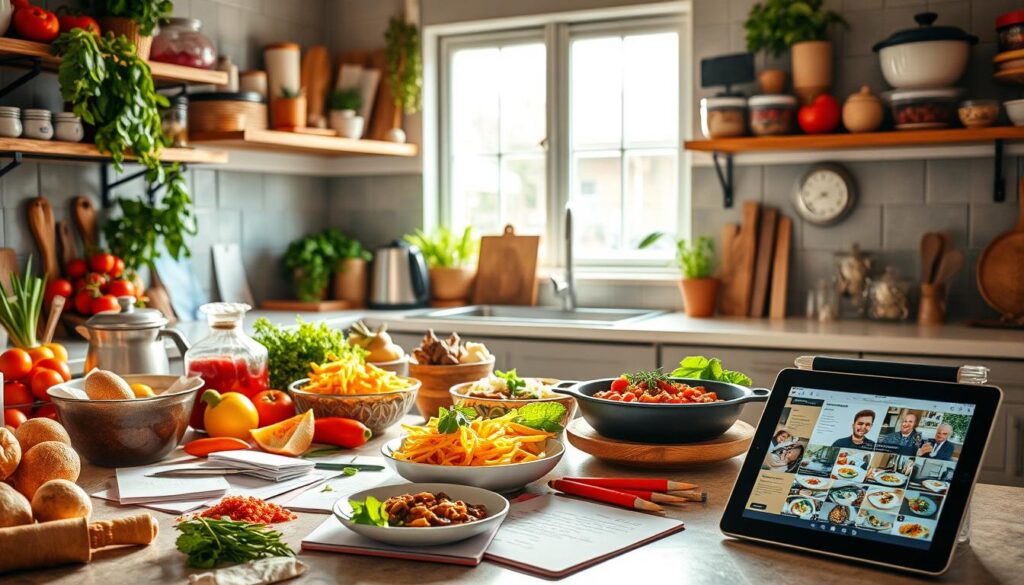
Diversifying Income Streams
Diversifying how you make money from recipes is crucial. You can offer online cooking lessons or write a cookbook. Cooking classes bring extra income and connect you with your fans, building loyalty.
A great recipe book can become a key part of your brand. Understanding costs is essential to keep making a profit. Starting a recipe product might need an investment between $50,000 to $120,000. This shows why it’s important to plan your finances.
As you expand your recipe business, use every tool available. This could be digital scales or advice from industry experts. For more tips on scaling recipes, check out this comprehensive guide.
Tools and Resources to Help You Sell Recipes
Diving into online recipe sales? You’ll want the right tools to make things easy and improve your efficiency. Shopify and WooCommerce are great for selling recipe books and e-books. And if you’re using WordPress, the WooCommerce plugin helps manage your digital products smoothly.
SEO optimization tools are also key. They help you find the right keywords for your recipes, making them easier to find in searches. This attracts more buyers. Also, high-quality photos and great descriptions catch customers’ eyes. Consider buying good camera equipment or taking a photography course to enhance your listings.
If you join online forums and groups about recipe selling, you can get lots of support. These communities keep you up to date with trends, provide tips from others, and let you share your own stories. Also, using social media platforms like Instagram and Facebook can help you reach more people. Try live sessions, blog posts, and giveaways to build a following. Remember, staying active with promotions helps keep sales going in this competitive field.







